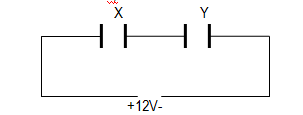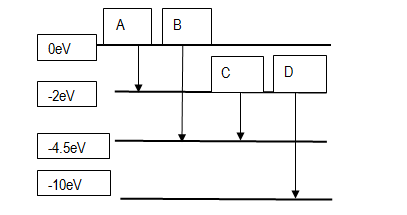Sample Paper of Physics 2014 for class 12, CBSE. Paper No.2
Sample Paper – 2014
Class – XII
Subject – Physics
Time: 3Hrs
No of pages: 04 M. Marks: 70
General instructions:
- All questions are compulsory.
- There is no overall choice. However, an internal choice has been provided in one question of two marks, one question of three marks and all three questions of five marks.
- Question numbers 1 to 8are very short answer type questions, carrying one mark each.
- Question numbers 9 to 18are short answer type questions, carrying two marks each.
- Question numbers 19 to 27are also short answer type questions, carrying three marks each.
- Question numbers 28 to 30 are long answer type questions, carrying five marks each.
- Use of calculator is not permitted. However, you may use log tables, if necessary.
- You may use the following values of physical constants wherever necessary:
| c= 3X108m/s h= 6.6X10-34Js e= 1.6X10-19C me= 9.31X10-31kg |
m0 = 4pX10-7TmA-1 mn= 1.67X10-27 kg
e0= 8.85X10-12C2N-1m-2 k= 1.38X10-23JK-1
| Q1. | Name the electromagnetic wave which is used to measure the speed of moving vehicles. | (1mark) |
| Q2. | Draw energy band diagram for p-type semi-conductor. | (1mark) |
| Q3. | The instantaneous current and voltage of an a.c. circuit are given by I=10sin300t A and V=200sin300t V. What is the power dissipated in the circuit for one complete cycle? | (1mark) |
| Q4. | Give a relation between path difference and wavelength for destructive interference between two waves. | (1mark) |
| Q5. | Define distance of closest approach. | (1mark) |
| Q6. | Name the physical quantity whose S.I. unit is Wbm-2. Is it a scalar or vector quantity? | (1mark) |
| Q7. | A wire has a resistance of 16Ω. It is melted and drawn into a wire of half its length. Calculate the resistance of the new wire. What is the percentage change in its resistance? | (1mark) |
| Q8. | Why does a metallic piece become very hot when it is surrounded by a coil carrying high frequency alternating current? | (1mark) |
| Q9. | At a point due to a point charge the value of electric field intensity and electric potential are 32N/C and 16J/C respectively. Calculate1 |
(a) The distance of charge from observation point.
(b) Magnitude of charge.
(2 marks)Q10.When the voltage drop across pn junction diode is increased from 0.65V to 0.70V, the change in the diode current is 5mA. What is the dynamic resistance of the diode? (2 marks)Q11.Name the radiations which are next to infrared radiations in electromagnetic spectrum having(a) Shorter wavelength.
(b) Longer wavelength.
Also give one use each of these wavelengths.
(2 marks)Q12.Why is Diamagnetism almost independent of temperature? (2 marks)Q13.What is diffraction of a wave? Why is diffraction phenomenon so common in sound waves but not so common in light waves?
OR
Two coherent sources, whose intensity ratio is 81:1, produce interference fringes. Calculate the ratio of intensity of maxima and minima in the fringe system.
(2 marks)Q14.Draw a neat diagram showing Chromatic Aberration for convex lens. (2 marks)Q15.By how much would the stopping potential for a given photosensitive surface go up if the frequency of the incident radiations were to be increased from 4 x 1015 Hz to 8 x 1015 Hz? (2 marks)Q16.Express 32mg mass into equivalent energy in eV. (2 marks)Q17.What is the De-Broglie wavelength associated with an electron, accelerated through a potential difference of 100 Volts? (2 marks)Q18.What do you understand by sensitiveness of a potentiometer and how can you increase thesensitiveness of a potentiometer?
(2 marks)Q19.ABC is an equilateral triangle of side 10cm. D is the mid point of BC. Charges 100µC, -100µC and 75 µC are placed at B, C and D respectively. What is the force experienced by a 1C positive charge placed at A? (3 marks)Q20.Explain with the help of circuit diagram why the output voltage is out of phase with the input voltage in a common emitter transistor amplifier (3 marks)Q21.Define polarising angle. Derive the relation connecting polarising angle and the refractive index of a medium. (3 marks)Q22.
Define the term temperature coefficient of resistivity. Write its S.I. unit. Plot a graph showing the variation of resistivity of copper with temperature.
OR
What is drift velocity of electrons and relaxation time of free electrons in a metallic conductor carrying a current? Establish a relation between them.
2(3 marks)Q23.The energy levels of an atom are as shown below. Which one of the transitions will result in the emission of a photon of wavelength 275 nm?
(3 marks)Q24.X and Y are two parallel plate capacitors having the same area of the plates. X has air between the plates and Y contains a dielectric medium of εr = 5.X Y
+12V-
(a) Calculate the potential difference between the plates of X and Y.
(b) What is the ratio of electrostatic energy stored in X and Y?
 (3 marks)Q25.Figure (a), (b) and (c) Show three alternating circuits with equal currents. If frequency of alternating emf be increased, what will be the effect on currents in the three cases? Explain.(a) (b) (c)
(3 marks)Q25.Figure (a), (b) and (c) Show three alternating circuits with equal currents. If frequency of alternating emf be increased, what will be the effect on currents in the three cases? Explain.(a) (b) (c)
 (3 marks)Q26.Draw a labelled ray diagram of an astronomical telescope for the near point adjustment. You are given three lenses of powers 0.5D, 4D and 10D. State with reason which two lenses will you select for constructing a good astronomical telescope. (3 marks)Q27.A series LCR circuit with L=0.12H, C=480nF, R=23Ω is connected to a 230V variable frequency supply.(a) What is the source frequency for which current amplitude is maximum?
(3 marks)Q26.Draw a labelled ray diagram of an astronomical telescope for the near point adjustment. You are given three lenses of powers 0.5D, 4D and 10D. State with reason which two lenses will you select for constructing a good astronomical telescope. (3 marks)Q27.A series LCR circuit with L=0.12H, C=480nF, R=23Ω is connected to a 230V variable frequency supply.(a) What is the source frequency for which current amplitude is maximum?
(b) What is the source frequency for which average power absorbed by the circuit is maximum? Obtain the value of this maximum power.
(c) What is the Q factor of the given circuit?
(3 marks)Q28.State Biot -Savart’s law. Using Biot-Savart’s law, derive an expression for the magnetic field at the centre of a circular coil of number of turns N, radius R, carrying current I.OR
Explain with the help of a labelled diagram the principle and construction of a cyclotron. Deduce an expression for the cyclotron frequency and show that it does not depend on the speed of the charged particle. 3(5 marks)Q29.Define the terms ‘potential barrier’ and ‘depletion region’ for a pn junction. Explain with the help of circuit diagram, the use of a pn junction diode as a full wave rectifier. Draw the input and output wave forms.OR
Explain briefly, with the help of a circuit diagram, how V-I characteristics of a pn junction diode are obtained in (i) forward bias and (ii) reverse bias. Draw the shape of the curves obtained.
(5 marks)
Paper Submitted by: Manish Harish
Email : mnshhrsh@yahoo.co.in
Mob No. : 9818223469























